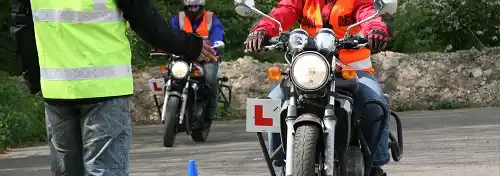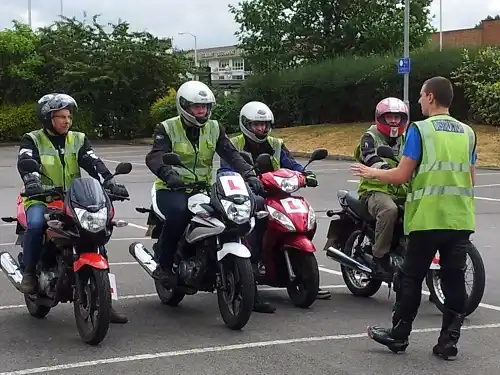Book motorcycle training in Dunfermline, Fife with any of the companies listed here
Click on any of the motorcycle training schools below to view more information and check availability.
Harleys Rider Training Edinburgh
357 Gorgie Road, Edinburgh, EH11 2RP
Approx. distance: 12.5 miles
Pro Scot Ltd Kirkcaldy
Mitchelson Industrial Estate, Kirkcaldy, Fife, KY1 3WE
Approx. distance: 12.6 miles
Jim Allan Motorcycle Training Falkirk
208 Grahams Road, Falkirk, Falkirk, FK2 7BX
Approx. distance: 13.7 miles
A2B Motorcycle Training WL Livingston
Unit 9, Centrex House, Simpson Place, Kirkton Campus, Livingston, West Lothian, EH54 7FN
Approx. distance: 13.7 miles
Cameron Bike Training Stirling
Unit 2B, Old Campbell house, Alva, Clackmannanshire, FK12 5DQ
Approx. distance: 14.1 miles
Lothian Motorcycle Training Bathgate
14e Blackburn Road, Bathgate, Lothian, EH48 2EY
Approx. distance: 14.7 miles
Two Wheels Motorcycle Training School Edinburgh
36 Peffermill Road, Edinburgh, Edinburgh, EH16 5LL
Approx. distance: 15.1 miles
Harleys Rider Training Glasgow
2 Glenburn Road, East Kilbride, Strathclyde, G74 5BA
Approx. distance: 36.3 miles
Biker School Glasgow
345 Renfrew Road, Glasgow, Glasgow City, G51 4SW
Approx. distance: 37 miles
Bike It Motorcycle Training Paisley
53 Clark Street, Paisley, Strathclyde, PA3 1RB
Approx. distance: 41.2 miles

Find motorcycle training in Dunfermline, Fife
Are you trying to book your motorcycle training in Dunfermline or close by in Rosyth, Inverkeithing and Dalgety Bay? Here at BookCBTNow we are one of the most trusted sources of online booking for motorcycle training companies. We can help you find your local training company and help you get your training for the A1, A2 or DAS motorcycle test.
What are the different types of motorcycle licence I can get in Dunfermline?
There are 4 main types of full motorcycle licence issued by the DVSA. The first three (AM, A1 and A2 motorcycle licences) have restrictions on the type of moped or motorcycle you can ride, the fourth (the full A motorcycle licence) has no restrictions.
The AM restricted moped licence
The A1 restricted motorcycle licence
The minimum age to take this test is 17. According to the DVSA website it will allow you to ride a "Light motorcycle up to 11 kW (and a power-to-weight ratio not more than 0.1 kW per kg) and 125 cc". This means it's up to a 125 cc motorcycle with some restrictions to make sure it cannot accelerate too fast - a really good idea when you are new to riding a motorbike!
Requirements to take the A1 motorcycle test - You must have a UK provisional or full driving licence, a valid theory test certificate and a valid CBT certificate. Once you have taken this test you will not have to keep renewing your CBT certificate every 2 years, you can ride on motorways and you can take a pillion passenger on the back of your motorbike.
The A2 restricted motorcycle licence
For this licence you need to be at least 19 years of age, have completed your CBT or have had an A1 licence for at least 2 years. As with the A1 test you also need to have a UK provisional or full driving licence and a valid theory test certificate . The main benefit of getting an A2 licence is you can ride a more powerful motorcycle. The law states a "standard motorcycle up to 35 kW (and a power-to-weight ratio not more than 0.2 kW per kg)". So it's a more powerful bike, but still not completely un-restricted. To find A2 legal motorbikes you are best visiting your local motorcycle dealer and asking them to show you the A2 legal bikes, as otherwise it's very difficult to work out just looking at the tech specs.
The full A motorcycle licence, or DAS licence.
This is the licence that allows you to ride almost any motorcycle without restrictions, so it's the ultimate motorcycle licence. No limits on power outputs or power per kg or engine size! It is also called a 'DAS' licence as it can be obtained from the 'Direct AccesS' route. There are two ways you can get this licence:
1) If you are 24 or over you can take the tests for an A licence. You must also have a UK provisional or full driving licence, a valid theory test certificate and a valid CBT certificate.
2) If you are at least 21 years of age and you have held an A2 category licence for at least 2 years. This is sometimes referred to as the 'progressive access' route as you progress from one licence to another.
When taking the test the biggest difference is that you have to use a bigger, more powerful motorcycle. It will have a power of at least 40kw and an engine cc of at least 595 cc. Your local training school will make sure you have the right size bike for your test.
There is also a flowchart (click here) that the DVLA have produced that shows these different licences and how to obtain them.
To get more detailed guidance on what licence is right for you then talk to your local motorcycle training school. You can search for them here and they are qualified to speak to you on the right type of training for you.
What can I ride on a provisional driving licence in Dunfermline?
A provisional driving licence is not a full driving licence so you are limited in what you can ride. So, when you first come to ride a motorcycle the DVSA will issue you with a provisional driving licence. What you can ride will depend on your age.
Age 16
You must complete a CBT and then you can ride a moped or scooter up to 50 cc and with a top speed of no more than 28 mph. You must display L plates, you cannot carry a pillion passenger and you must not ride on a motorway.
Age 17 or over
You must complete a CBT and then you can ride a restricted motorcycle up to 125 cc. You must display L plates, you cannot carry a pillion passenger and you must not ride on a motorway.
Do you have a full car driving licence?
If you already have a full car driving licence then this automatically gives you provisional entitlement for riding a motorcycle. So, priovided you get your CBT certificate then you can ride a moped or motorcycle as mentioned above according to your age.

If I have a full car driving licence what motorcycle can I ride?
This depends on when you passed your driving test:
If you passed your car driving test before 1st February 2001
In this case you can ride a moped up to 50 cc without Learner plates and without needing a CBT. If you want to ride anything bigger then you will need to get your CBT certificate. Then you will be able to ride a restricted motorcycle up to 125 cc with Learner plates displayed.
If you passed your driving test on or after 1st February 2001
You must obtain a CBT certificate before you can ride anything. Once completed you can ride a moped or restricted motorcycle up to 125 cc.
When can I take a pillion passenger on the back of my motorcycle?
In order to carry someone on the back of your motorbike you need to have a full motorcycle licence. This means one of the AM, A1, A2 or full A (also known as DAS) licences. This means that you cannot carry a pillion passenger if you only have a provisional licence, even if you have done a CBT. A CBT is not enough for you to take a pillion under any circumstances.
Even when you have passed your full motorcycle test you will need to make sure your motorcycle is properly equipped to take a pillion. As the rider you are legally responsible for your passenger, so it is very much in your interests to make sure your motorcycle is properly equipped. This means making sure there is a proper seat with foot rests and grab rail to hold on to. Your passenger must also wear a safety helmet (as well as all the other protective clothing!). Don't forget also that riding a motorcycle with a pillion is quite different than riding solo, so read up about the changes you need to make to your motorbike and riding style before attempting to take a pillion passenger.